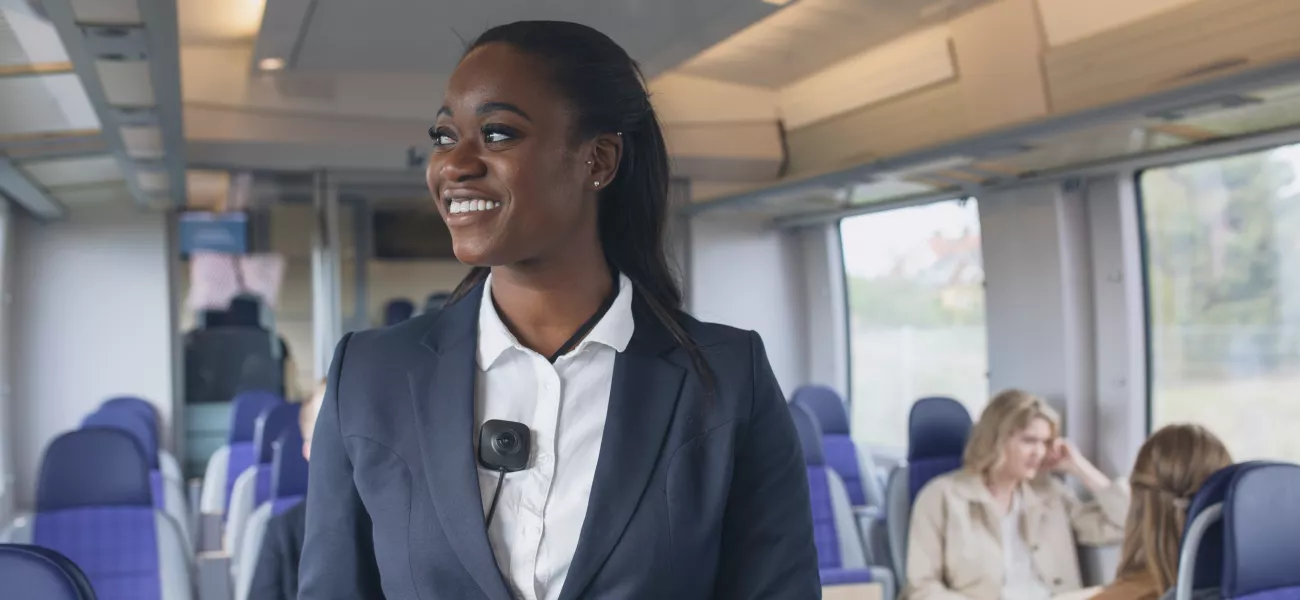
The usefulness of body worn cameras in law enforcement and security segments has been established. In the US, body worn solutions are even becoming mandatory for law enforcement agencies, state by state. Yet the availability of open-platform body worn cameras and increasingly smaller, lighter, and more discreet sensors has made this technology ideal for addressing the needs of a much wider range of industries today, from healthcare to retail and more.
Deterring unwanted behavior
Unfortunately, dealing with disorderly, aggressive, or violent behavior is the norm for employees in many industries, from bus drivers to nurses to retail workers. This is not only a nuisance, but it also potentially poses a threat to these individuals, business operations, and the general public.
People in public-facing jobs, such as retail staff, face acts of aggression or violence from angry customers and members of the public on a daily basis. The US Bureau of Justice found that despite retail workers comprising 9% of the US workforce, they accounted for 13% of all workplace violence incidents. In fact, retail was identified as the third-riskiest industry to work in, after law enforcement and mental health, in terms of the rate of workplace violence and victimization.
Equipping your workforce with a body worn camera adds a visible deterrent, helping your teams diffuse disorderly conduct before it escalates. When someone is inclined to threaten your staff and realizes they are being recorded, they’re more likely to calm down or walk away due to fear of the consequences of aggressive behavior. In instances where the presence of the camera does not de-escalate unwanted behavior, solutions with livestreaming capabilities can reassure staff that they are not alone. With one click, they can stream footage of the escalating situation directly to an operator, ensuring that the situation is being observed and making it easier to get additional support at the scene. From grocery stores to pharmacies and healthcare facilities, more organizations are implementing body worn camera solutions so staff can de-escalate issues and feel safer at work.
In addition to deterring an escalation of bad behavior, the presence of cameras can discourage undesired or criminal behavior entirely. For example, in public transport, deploying body worn cameras amongst your staff both protects them and discourages other anti-social behavior, from vandalism to littering. Similarly, while banks are a target for criminals, pick-up officers and others involved in cash-in-transit can feel safer knowing that everything that is said or happens is being recorded, and thieves are less likely to target them.
Forensic search and enabling legal action
If an incident occurs, having a first-hand audio and video recording can help you establish the cause or identify suspects. It can even help assess fault when it’s a case of someone’s word against someone else.
Body worn cameras record incidents as they appeared to the camera wearer, and as they sounded to everyone involved in the situation. Solutions available today can deliver sharp audio and best-in-class tamper-free video that is suitable for use during investigations and in court. When combined with traditional video surveillance, they provide valuable additional insight for incident analysis.
This is vital for sectors which regularly deal with conflict or criminal activity in the workplace, such as healthcare. The World Health Organization reports that between 8% and 38% of health workers experience physical violence at some point in their careers. To ensure these instances are met with consequences, you can use body worn cameras to obtain first-hand untampered documentation.
Disputes between patients and healthcare or social assistance organizations can use the body worn video footage to come to a resolution. It documents events and situations where an assault has taken place, helping enable legal action to be taken where necessary.
Helping to train staff
No matter the industry, body worn video footage can be used as an important part of training. It provides valuable audio and visual recordings from a user perspective, creating a realistic learning environment that can be hard to replicate in real-life. It's a powerful way to share knowledge and experience when training resources are limited.
In sectors like critical infrastructure, maintenance workers can capture visuals from their perspective to illustrate safety routines, the order to perform different tasks, how they are performed and so on.
As another example, skills labs and simulation training are a regular part of continuing education for trauma teams in healthcare – a sector where training has life or death consequences. Video footage from body worn cameras captures important visual recordings from the healthcare worker’s perspective as well as audio recordings of the trauma team's communication – both of which can be reviewed later to assess team performance and optimize techniques.
Ensuring compliance and liability protection
Compliance is key to ensuring the health and safety of staff, and that processes and protocols are maintained. It protects you and your workforce against expensive liability claims.
Body worn camera solutions provide proof that employees are conducting their work in a safe and proper manner, and that the surrounding working environment doesn't pose a threat. The video and audio recordings offer undisputed evidence of how situations were handled as they happened. This is valuable across every industry, but a few examples include:
- Retail: Store audits can be tricky given they cover every detail within operations, loss prevention, customer experience, health and safety etc. Body worn cameras make it easier to document any incidents that occur and protect you from compensation claims.
- Healthcare: In addition to documenting compliance with health and safety regulations, such as hand hygiene, body worn cameras can also help manage the challenge of drug diversion. Footage provides proof that medication is dispensed accurately, as well as acting as valuable evidence against potential litigation if a patient has an adverse reaction to medication.
- Logistics: Body worn cameras provide valuable last-mile confirmation that a package was delivered, what condition it was in and who received the package, minimizing the risk of paying out for false liability claims.
Proving usefulness beyond law enforcement and security
Even the smallest body worn camera sensors with a diameter of less than one inch can capture sharp images in the most challenging conditions – whether a maintenance worker is running routine checks in the rain, or a delivery driver is dropping off a package in the evening. Despite the huge advances which have made this possible, more exciting developments are just around the corner.
These cameras can act as sensors, sharing valuable input into smart city grids. They can capture a cutting-edge medical procedure to help train the next generation of surgeons or catch a shoplifter red-handed to ensure their actions have consequences. Body worn cameras today address many challenges across industries. And as the technology advances further, new demand and new ways to use this equipment will no doubt emerge to address the challenges of tomorrow too.
